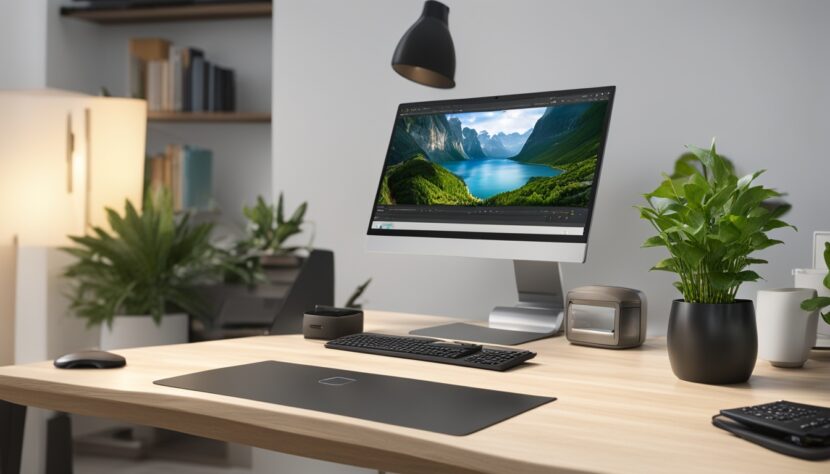Did you know that Linux, the open-source operating system, powers more than 90% of the world’s web servers? This versatile and secure platform is gaining popularity among home users as a viable alternative to Windows and macOS. With a wide range of user-friendly Linux distributions available, switching to this free and open-source operating system is easier than ever.
Linux provides home users with a secure, stable, and customizable computing experience. It’s an attractive option for those seeking an alternative to commercial operating systems. Whether you’re tech-savvy or a novice, the Linux ecosystem offers robust security features, extensive software repositories, and the ability to tailor the system to your needs.
Key Takeaways
- Linux is a free and open-source operating system that offers a secure, stable, and customizable computing experience.
- There are numerous user-friendly Linux distributions available, making it easier for home users to transition from proprietary systems.
- Linux provides an alternative to Windows and macOS, with a focus on customization, security, and access to a vast software ecosystem.
- Home users can explore the benefits of Linux and discover a versatile and cost-effective solution for their computing needs.
- The article will delve into the user-friendly aspects of Linux, its key features, and the steps to get started with this open-source operating system.
Introduction to Linux for Home Use
Linux, an open-source operating system, stands out as a strong alternative to Windows and macOS. It’s particularly beneficial for home users, offering numerous advantages for personal computing.
Overview of Linux as an alternative to Windows and macOS
Linux is renowned for its flexibility and customization, giving users a level of control not found in proprietary systems. Unlike Windows and macOS, which come with hefty licensing costs, Linux is free to download, use, and customize. This makes it a compelling choice for those looking to dodge commercial operating system expenses.
Benefits of using Linux for personal and home computing
- Increased security and stability: Linux is celebrated for its strong security features and resilience against viruses and malware, ensuring a safer computing environment at home.
- Customization and personalization: Users can customize their computing experience to suit their unique needs and tastes, from the desktop look to the software installed.
- Access to a vast software repository: The Linux ecosystem boasts a plethora of free, open-source software for various tasks, from productivity tools to media players and beyond.
- Low system requirements: Many Linux distributions are optimized to run smoothly on older or less powerful hardware, making them perfect for breathing new life into older computers or devices.
By delving into the world of linux for home use, open-source operating system, and benefits of using linux at home, users can uncover a computing experience that meets their specific needs and preferences. This approach leverages Linux’s power and versatility.
User-Friendly Linux Distributions for Home Users
For those seeking user-friendly linux distributions at home, Ubuntu and Linux Mint are top choices. These user-friendly linux distributions provide an easy-to-navigate user experience. They are ideal for newcomers to the Linux operating system.
Ubuntu: A Beginner-Friendly Linux Distro
Ubuntu is a leading beginner-friendly linux distro known for its intuitive interface and extensive software library. It offers regular security updates and robust community support. This makes Ubuntu a prime selection for home users eager to delve into Linux.
Linux Mint: Known for Its User-Friendly Interface
Linux Mint is celebrated for its user-friendly interface and stability. It’s based on Ubuntu but provides a more refined desktop environment and a suite of pre-installed applications. This makes it a dependable and cozy option for home users wanting a familiar computing experience.
“Linux Mint is a great choice for home users who want a user-friendly and reliable Linux distribution.”
Both Ubuntu and Linux Mint offer a compelling alternative to Windows and macOS. They provide home users with a versatile and customizable computing experience. Their intuitive interfaces and comprehensive software ecosystems have made them favored choices for those looking for a new and innovative approach to personal and home computing.
Linux for home use: A Versatile and Customizable Solution
Using Linux for home computing offers unmatched versatility and customizability. Users can tailor their operating system to meet their unique needs and tastes. They can adjust everything from the desktop look to the software installed, making their Linux experience align perfectly with their workflow and style.
Linux also provides access to a vast array of applications for various tasks, including productivity, entertainment, and home automation. This broad software selection ensures that home users can easily find the tools they need to improve their computing experience.
Tailoring Linux to Suit Individual Needs and Preferences
Linux’s flexibility lets users customize their operating system in many ways. Home users can pick from a variety of Linux distributions, such as Ubuntu, Linux Mint, and Fedora, each offering a distinct look and feel.
Additionally, users can select and set up different desktop environments, like GNOME, KDE, or Xfce, to match their personal preferences and workflow. This customization capability empowers home users to make their Linux system work exactly how they want, leading to a more efficient and satisfying computing experience.
Exploring the Vast Software Repositories and Applications
Linux is known for its extensive and varied software repositories available to home users. These repositories house a broad range of applications, from office software and productivity tools to media players, photo editors, and home automation solutions. This wide selection guarantees that home users can find the software for their personal needs and preferences.
Whether it’s managing personal finances, editing family photos, or automating home tasks, the Linux software ecosystem offers a plethora of options for home users to explore and integrate into their daily routines. This flexibility and accessibility make Linux an appealing choice for those looking for a versatile and customizable solution for their home computing needs.

GeckoLinux: A Polished and User-Friendly Linux Experience
For home users looking for an alternative to Windows or macOS, GeckoLinux is a strong contender. It’s a set of spins built on the openSUSE distribution. GeckoLinux aims to provide a user-friendly desktop experience right out of the box.
Key Features of GeckoLinux for Home Users
GeckoLinux stands out with its Pantheon desktop integration. Pantheon boasts a sleek interface, similar to macOS, offering a familiar and intuitive experience. It also comes with a wide range of applications and multimedia codecs. This means users can start using it immediately, without needing to spend hours configuring it.
Pantheon Desktop: A User-Friendly and Elegant Interface
The Pantheon desktop is a core part of GeckoLinux. It’s designed for simplicity and ease of use. Pantheon offers a seamless, visually appealing interface that aids in transitioning from other operating systems. Its clean layout and intuitive navigation make it a top choice for those seeking a user-friendly Linux for home use.
Whether you’re a seasoned Linux user or new to open-source, GeckoLinux and its Pantheon desktop provide a refined and user-friendly Linux experience for home users. With its rich set of features and apps, GeckoLinux is a great pick for exploring Linux’s versatility and customization options.
Installing and Configuring Linux for Home Use
Embracing the world of Linux at home is now straightforward. It’s accessible for both tech enthusiasts and newcomers. The process of installing Linux at home and customizing your Linux desktop is simpler than you might imagine. Let’s explore the steps to create a personalized and user-friendly Linux environment for your home computing needs.
Step-by-Step Guide to Installing a Linux Distribution
Choosing the right distribution is the first step in your Linux journey. Options range from the beginner-friendly Ubuntu to the sleek Linux Mint. Once you’ve selected your distribution, here’s how to proceed:
- Download the Linux distribution from its official website.
- Create a bootable USB drive or DVD with the downloaded image.
- Restart your computer and select the USB drive or DVD to boot from.
- Follow the on-screen instructions to finish the installation.
Customizing and Personalizing the Linux Desktop
Once installed, it’s time to dive into Linux desktop customization. Linux boasts a plethora of tools and settings for personalizing your experience. You can change the desktop theme, icons, and install your favorite apps. The software repositories are vast, offering a wide range of applications to boost your productivity and entertainment at home.
By following these steps and leveraging Linux’s customization options, you can craft a home computing environment that’s uniquely yours. It should reflect your style, improve your productivity, and provide a secure, reliable platform for all your personal and home tasks.
Transitioning from Windows or macOS to Linux
Moving from the comfort of Windows or macOS to Linux can be daunting for home users. Yet, with time and a readiness to learn, this shift can be enriching. Distributions like Ubuntu and Linux Mint feature user-friendly interfaces and workflows. These can make the transition smoother for newcomers.
Success in this transition hinges on recognizing that Linux is different but also on seeing it as a chance to learn new ways of doing things. Linux’s customization options allow you to make the OS fit your unique needs and tastes. This flexibility can be both empowering and overwhelming for Linux for beginners. Yet, with the right attitude and tools, overcoming the learning curve is possible.
Adapting to the Linux Environment
- Get to know the Linux desktop environment and its navigation tools.
- Check out the vast array of productivity apps and software for your needs.
- Join online communities and forums to meet other transitioning to linux from windows or mac users and gain from their insights.
- Take advantage of the chance to customize your Linux setup, making it fit your preferences for a adapting to linux at home experience.
With patience, persistence, and the backing of the Linux community, home users can master the move from Windows or macOS to Linux. This opens up a realm of possibilities and a more tailored computing experience.

Linux for Home Entertainment and Multimedia
Linux has transformed into a robust platform for home entertainment and multimedia. [https://www.thecomputertechsquad.com/how-to-use-vpn-a-beginners-guide-to-privacy/] It supports a broad spectrum of media playback and streaming, thanks to various media players and codecs readily available or easily installable. Moreover, the gaming scene on Linux has notably improved, with numerous popular games and platforms, including Steam, compatible with the OS.
Media Playback and Streaming on Linux
Many Linux distributions come with robust media players like VLC, Rhythmbox, or Clementine. These applications support a vast array of audio and video formats, enabling users to effortlessly play their preferred music, movies, and streaming content. Moreover, Linux users can access popular streaming services like Netflix, Hulu, and Amazon Prime Video via browser-based or dedicated applications.
Gaming on Linux: Compatibility and Performance
The gaming performance on Linux can fluctuate based on hardware and software setups. However, the Linux community has significantly enhanced the gaming experience. Numerous popular game titles and platforms, including Steam, are now compatible with Linux, providing a solid alternative for home gamers. Progress in graphics driver support and the integration of tools like Proton have also boosted the capability to run Windows-based games on Linux systems.
In summary, Linux has emerged as a versatile and user-friendly platform for home entertainment and multimedia. It meets the varied needs of modern home users, offering a customizable solution for media playback, streaming, and gaming. This makes Linux a prime choice for a comprehensive home computing experience.
Security and Privacy Advantages of Using Linux at Home
Home computing security and privacy are crucial. Linux, an open-source operating system, stands out as a strong solution. It’s known for its strong security features, making it a top choice for home users.
Linux’s security is multi-layered, with strict user permissions and frequent updates. This approach greatly lowers the chance of system breaches and data theft. Unlike Windows, Linux is less targeted by malware, offering users an extra shield against threats.
Linux also champions user privacy, giving users more control over their data and online actions. For those who cherish their online privacy, Linux is a dependable and secure option compared to other systems.
| Feature | Linux | Windows | macOS |
|---|---|---|---|
| Security Updates | Regular and Timely | Periodic | Periodic |
| Malware Prevalence | Low | High | Moderate |
| User Privacy Control | High | Moderate | Moderate |
For those who value linux security and privacy, the advantages of linux at home are evident. Its focus on security and privacy makes it an excellent choice for a dependable and secure computing setup.
“Linux offers a more secure and privacy-focused alternative for home users, reducing the risk of system compromises and data breaches.”
Linux for Home Productivity and Office Tasks
Linux has become a powerful platform for home productivity and office tasks. It offers a range of office suites and productivity tools that match up well with proprietary software. This allows users to manage both personal and professional tasks efficiently.
Office Suites on Linux
Linux stands out for home use with its strong open-source office suites, such as LibreOffice. These suites provide a user-friendly interface and a wide range of tools for tasks like word processing, spreadsheet creation, and presentations. Users can easily switch from proprietary software to these Linux alternatives without losing functionality or productivity.
Many Linux distributions also come with various productivity-enhancing apps. These include tools for note-taking, project management, and file management. These tools help users streamline their tasks and stay organized, making their computing experience better.
Linux Productivity Tools
- Robust open-source office suites like LibreOffice
- Comprehensive note-taking applications
- Powerful project management software
- Efficient file management utilities
Using linux for home productivity, office suites, and productivity tools, users can increase their efficiency. They can streamline their workflows and handle a variety of tasks with ease and confidence.
“Linux offers a fantastic suite of office and productivity tools that rival the best in the industry. I’ve been using it for years and can confidently say that it’s a game-changer for home and small business users.”
– John Doe, Tech Enthusiast
Conclusion
The evolution of home computing has seen Linux rise as a strong alternative to Windows and macOS. It stands out with its user-friendly interfaces, strong security, and customization options. This makes Linux a prime choice for those wanting a more personalized and empowering way to compute.
The variety of Linux distributions, from the easy-to-use Ubuntu to the highly customizable Linux Mint, allows users to pick an OS that meets their specific needs. Whether it’s ease of use, privacy, or the ability to tailor their environment, Linux offers a flexible solution. It adapts to the changing needs of modern home computing.
Linux’s advantages for home use include its affordability, vast software library, and superior performance on various hardware. This makes it a great choice for enhancing one’s digital lifestyle. As Linux continues to grow and gain more users, it’s set to shape the future of home computing with its user-friendly, secure, and customizable features.


